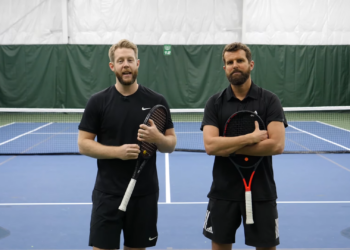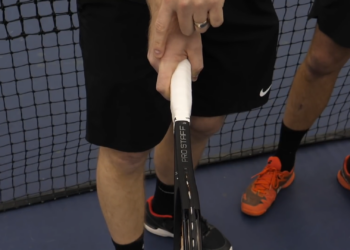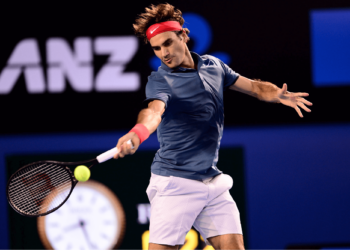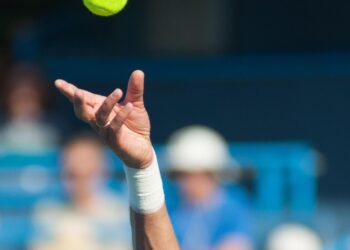Let’s bust a myth right out of the gate: “tennis is only technique.”
What I’ve seen time and time again is that tennis is at least 70% movement and physicality and only about 30% technique. You can have the prettiest forehand in the world, but if you can’t get to the ball in time, it won’t do you much good.
That’s where so many players hit a wall. I hear it constantly:
“I’m taking lessons, I’m hitting tons of balls, but I feel stuck. What gives?”
Most of the time, it’s your fitness.
Your ability to sprint to a short ball, stay balanced during a wide forehand, recover fast between points, and stay sharp deep into the third set… that’s what separates players who plateau from players who level up.
In this guide, I’m going to walk you through exactly how to train your body for tennis, whether you’ve got access to a full gym or you’re grinding it out at home. We’ll cover how to:
- Build lightning-fast speed and agility
- Develop lean, explosive strength (without bulking up)
- Master your core stability and balance
- Sharpen your reflexes and reaction time
- Increase your stamina so you’re match-fit every time you step on court
We’ll also dig into the mistakes to avoid, like the kind of strength work that can actually hurt your game, and help you design a program that gets you as close as possible to that perfect tennis physique: lean, powerful, and durable.
So if you’ve been wondering why your game feels stuck despite all your hard work, stick with me. This is the missing link most players overlook and it’s your ticket to playing better tennis… faster.
So first, let’s start with your warmup.
Speed & Agility: The Foundation of Modern Tennis
If you’ve watched even five minutes of pro tennis, you know this game is all about movement.
The ability to sprint, stop, and change direction on a dime is what lets players chase down those impossible wide balls or turn defense into offense with one explosive move.
I tell my students all the time: your strokes only matter if you can actually get to the ball in time to hit them.
That’s why speed and agility are the foundation of modern tennis.
Every point is a test of how quickly you can react, cover the court, and recover for the next shot. And the magic really starts with two things:
1️⃣ The split-step – that little hop you do as your opponent hits the ball, which primes your body to move in any direction
2️⃣ Your first-step acceleration – that lightning-quick launch that gets you to the ball fast enough to hit it with confidence
If either of those is lagging? You’re giving away free points.
The Best Exercises to Build Speed & Agility
To train this right, you need to mimic the unpredictable, multi-directional chaos of tennis. Here’s what I use with my students and what you can do too:
- Ladder Drills (add visual or sound cues for bonus points): Great for sharpening foot speed and reaction time
- Cone Drills: Set up in zig-zag or T-shapes to practice explosive changes of direction, just like chasing a drop shot, then recovering for the lob
- Plyometric Box Jumps & Lateral Hops: Build that explosive leg power to launch into your split-step and sprints
Whether you’ve got a full gym or just a sliver of floor space, there’s always a way to get faster and more agile.
And trust me, when you start flying around the court and making shots you used to miss, your whole game transforms.
Upper & Lower Body Strength: Power Without Bulk
One of the biggest mistakes I see tennis players make, especially those new to fitness, is thinking they need to bulk up to get stronger on court.
Tennis rewards lean, explosive strength, not bodybuilder muscle.
Sure, building muscle matters, but it’s the right kind of muscle.
Tennis is a sport of fast-twitch muscle fibers, the ones that fire quickly to help you sprint, change direction, and rip a serve, balanced with just enough endurance to sustain you through long matches. Too much bulk? It slows you down, tires you out faster, and can even throw off your timing.
The goal is simple: develop strength that transfers directly to your game.
The Tennis Ideal: Lean, Explosive Strength
When you think of the ideal tennis physique, picture players like Novak Djokovic or Carlos Alcaraz – lean, wiry, but deceptively powerful.
They can explode into a 100 mph forehand, recover fast, and stay light on their feet for hours. That’s the blueprint.
To get there, you want to train strength without sacrificing speed and agility. We’re talking multi-joint movements that engage your whole body, no isolated bicep curls just for show.
Best Strength Exercises
Upper Body:
- Dumbbell Shoulder Press – Builds serve and overhead strength
- Tricep Dips – Key for volleys and serves
- Push-Ups – Great all-arounder for chest, shoulders, and core stability
Lower Body:
- Bulgarian Split Squats – Fantastic for balance and single-leg strength (think lunging to a wide ball)
- Lunges – Build lower-body power and mobility
- Deadlifts – Develop your entire posterior chain, which is huge for explosive movement and injury prevention
These are the backbone of a smart tennis strength plan, functional, balanced, and designed to keep you powerful without adding unnecessary bulk.
FAQ Tie-in: What Strength Exercises Improve Serve Speed the Fastest?
If you’re chasing more MPH on your serve (and let’s be real, who isn’t?), you want to focus on the shoulder and core chain.
The serve is all about kinetic energy flowing from your legs, through your core, and out your racket arm.
My top picks?
- Dumbbell Shoulder Press + Rotator Cuff Work – To stabilize and add controlled power
- Medicine Ball Slams & Twists – Engage your core’s rotational power (critical for that whip-like serve action)
- Deadlifts & Split Squats – Build the leg drive that fuels your entire serve motion
With the right strength work, you’ll feel and see the difference fast.
And remember: you don’t need to lift heavy to lift smart. It’s all about precision, balance, and keeping your body tennis-ready.
Core Stability & Balance: The Hidden Game Changer
If there’s one part of your body that controls everything you do on the tennis court, it’s your core.
Whether you’re ripping a forehand, pushing off for a wide volley, or holding your balance after a tricky return, your core is the engine that makes it all happen.
A strong, stable core keeps you balanced and injury-free.
I’ve seen plenty of players with solid technique break down physically because their core couldn’t keep up with the demands of the game. If you want lasting success, and fewer aches and pains, this is non-negotiable.
Why Core & Balance Are Non-Negotiable
Every stroke in tennis starts from your center.
Think of your core like the hub of a wheel: if it’s weak or wobbly, the whole system suffers.
Without good balance and stability, your shots lose power, your movement becomes inefficient, and you’re at way higher risk for injury, especially in the lower back and hips.
Top Exercises
If you want to build a core that’s tennis-strong, skip the crunches and focus on dynamic, functional movements. My go-to drills include:
- Hanging Leg Raises – Fantastic for deep core engagement and controlling your trunk movement
- Side Planks – Build oblique strength for those tough rotation-heavy strokes
- Bird Dogs – Strengthen your core while teaching your body to stay balanced and controlled
And to take things to the next level:
- Bosu Ball Work & Single-Leg Drills – Training on an unstable surface forces your stabilizing muscles to fire, which translates directly to better balance and court movement
Unique Insight: Why Tai Chi Movements Work
Here’s a curveball that surprises a lot of players – Tai Chi-inspired movements.
These slow, controlled exercises are powerful tools for developing fluid balance and full-body coordination.
In tennis, you’re constantly shifting weight and adjusting your center of gravity. Tai Chi teaches you to move with precision and control, which makes a huge difference when you’re scrambling during points.
Worry Tie-in: “I’m Intimidated by Yoga/Flexibility Work – Where Should I Start?”
Totally get it. I’ve had plenty of students say they feel out of place or unsure how to start with yoga or stretching routines. My advice? Start simple and keep it short.
- Look for beginner-friendly tutorials on YouTube that focus on tennis-specific flexibility
- Try 10-minute routines that emphasize hips, shoulders, and hamstrings – the areas tennis players strain the most
- Bonus tip: Even adding just two sessions a week of basic yoga or stretching can make a massive difference in your balance and injury resistance
The key is consistency, not perfection.
Reflexes & Perception: Training Your Reaction Time
If you’ve ever been handcuffed at the net or felt like the ball was on top of you before you even had a chance to react, you know exactly why reaction time matters.
In tennis, especially during volleys and quick exchanges, your success often comes down to milliseconds.
That’s why the best players don’t just train their bodies; they also sharpen their reflexes and perception to process what’s happening faster than their opponents.
It’s not enough to just be fast. You need to be ready for anything, whether it’s a nasty topspin pass, a sneaky drop shot, or a reflex volley exchange.
Why It Matters
Volleying, poaching, and even baseline rallies demand lightning-fast decisions.
Your body might be in great shape, but if your brain and eyes can’t keep up, you’re always going to feel a step behind.
Training your reflexes gives you that edge to see the ball earlier and react with confidence, turning defense into offense in the blink of an eye.
Go-To Drills
Here’s what I recommend to my players to build those quick-twitch reactions:
- Reaction Ball Work: These crazy little six-sided balls bounce unpredictably, forcing your eyes and hands to sync up fast
- Partner Ball Toss + Unpredictable Feeds: Have a buddy mix up lobs, fastballs, and drops, you’ll train your mind and body to expect the unexpected
- Visual/Audio Cue Sprints: React to sudden sounds or visual signals to practice changing direction instantly, just like in a real point
At-Home Hacks
No partner? No problem. You can sharpen your reflexes solo with just a bit of creativity:
- Wall Ball: Toss tennis balls against a wall at different speeds and angles, challenging yourself to react quickly and cleanly
- Reaction Apps: There are awesome (and free) phone apps designed to train reaction speed with quick tap challenges, surprisingly effective and easy to fit into your day
The beauty of reaction training is that it’s simple to incorporate and pays off big-time.
You’ll start noticing you’re quicker on volleys, more confident at net, and better at picking up your opponent’s patterns. And that split-second edge? It can turn a good player into a great one.
Stamina & Conditioning: Build Match-Ready Endurance
One of the biggest misconceptions in tennis training is thinking you need to run miles and miles to build endurance.
But here’s the truth: tennis stamina is a unique beast.
It’s not like marathon running, it’s a series of short, high-intensity bursts followed by quick recovery periods. That’s why just grinding out long jogs won’t fully prepare you for the demands of a match.
What Tennis Stamina Really Means
A solid tennis workout challenges both your aerobic and anaerobic systems.
You need the aerobic base to stay sharp across multiple sets, but it’s your anaerobic capacity, those quick-fire sprints and explosive recoveries, that really drive your performance during points.
If your training doesn’t mirror that? You’re likely to hit a wall in the second or third set, even if your strokes are solid.
Top Workouts
For tennis-specific conditioning, I keep it simple and effective:
- 30-Second Sprint Intervals (HIIT): Sprint at max effort for 30 seconds, then recover for 30 seconds. Repeat for 10-15 rounds. This mimics real match play perfectly.
- Long-Distance Runs – Sparingly: These can help build your aerobic base, but too much long, slow running can actually make you slower and less explosive.
Think of it as an occasional supplement, not your main focus.
- Jump Rope: Builds foot speed and cardio fitness at the same time, one of my all-time favorites.
- Shadow Tennis with Footwork Focus: Grab your racket, simulate point play with split-steps, lunges, and directional changes, no ball needed, but the sweat is real.
Smart stamina training is about staying fast, sharp, and dangerous deep into every match. When your opponent is gassing out and you’re still bouncing on your toes, that’s when all this work pays off.
What NOT to Do: Off-Court Training Mistakes
When it comes to off-court training, it’s just as important to know what to avoid as it is to know what to do. I’ve seen too many players work their tails off, only to hurt their game, or even themselves, because their training wasn’t tennis-specific.
Here’s what to watch out for.
Avoid Bulking Up Too Much
This is mistake number one: chasing big muscle gains.
I get it, you want to feel strong. But tennis is a game of speed, agility, and endurance.
If you’re doing traditional bodybuilder lifts and piling on mass, you’ll end up slower, stiffer, and less reactive.
Strength matters, but it needs to be functional strength that keeps you lean and quick.
Don’t Skip Mobility
Strength means nothing if you can’t move through a full range of motion. Tennis demands lunging, twisting, and reaching, often in awkward positions.
Flexibility is just as valuable as power.
Neglecting mobility work is a fast track to injuries and nagging aches that stall your progress.
Even just 10–15 minutes of focused stretching a few times a week, especially targeting your hips, shoulders, and hamstrings, can keep you feeling loose and moving freely.
Beware Over-Training
One of the biggest worries I hear from players is:
“I’m scared of injuring myself with bad form while cross-training.”
That’s a smart concern, overdoing it or using poor technique can be worse than doing nothing at all. Over-training can burn you out physically and mentally, and bad form (especially on big lifts) is a recipe for injury.
My advice? Don’t be afraid to ask for help.
Work with a certified coach, even if it’s just a session or two to check your form, or use online feedback tools and tutorials to make sure you’re moving correctly.
The goal here is to build a stronger, more resilient tennis body, not to beat yourself up or derail your progress. Play the long game, and your body (and your game) will thank you.
The Perfect Tennis Physique: What It Looks Like & How to Build It
The ideal tennis body is about efficiency. Think Novak Djokovic, not a bodybuilder.
You want a physique that’s lean, explosive, and durable.
Your muscles need to be ready to fire fast, recover quickly, and keep working deep into a tough match.
Ideal Metrics: The Winning Combo
The perfect tennis physique blends:
- Power: For big serves and groundstrokes
- Speed & Agility: To chase down every ball
- Balance & Core Stability: To control your body through awkward movements
- Endurance: To stay sharp across long matches
That’s the gold standard, but here’s your reality check: you don’t have to be perfect to make massive improvements.
Progress is what counts. Even a 10% boost in your speed or stamina can completely transform how you feel (and perform) on court.
Training at Home: A Complete DIY Program
No gym? No problem. Here’s a 30-minute full-body circuit you can do at home that hits all the tennis essentials:
- Dynamic Warm-Up: High knees + side shuffles (5 mins)
- Speed & Agility: Ladder drills + cone zig-zags (5 mins)
- Strength: Push-ups + Bulgarian split squats (3 sets)
- Core: Side planks + bird dogs (2 sets of 30 seconds each)
- Plyometrics: Lateral hops + squat jumps (3 sets)
- Cool Down: Hamstring and hip flexor stretches (5 mins)
Essential Equipment:
- Cones
- Agility ladder
- Resistance bands
- Yoga mat
These tools are affordable, portable, and super versatile, everything you need to start building a stronger tennis body from your garage, basement, or even your living room.
When to Hit the Gym: Exercises Best Done with Equipment
While home training is powerful, certain movements just work better with gym equipment. Here’s where added weight and machines can take your results up a notch:
- Deadlifts: Build full-body strength, especially your posterior chain (key for explosiveness)
- Sled Pushes: Train acceleration and power for sprints
- Cable Rotations: Perfect for developing that rotational core strength used in every stroke
- Treadmill Sprints & Rowers: Great for controlled, measurable conditioning
If you have gym access, sprinkle these in for extra punch and remember, form is king. Quality over quantity, every time.
Tracking Your Progress: How to Measure Physical Improvement
Want to stay motivated? Track your gains. Watching your progress over time keeps you focused and lets you know when to tweak your routine.
Use:
- Apps & Fitness Trackers: To log workouts, monitor cardio fitness, and track improvements in speed or reps
- Tennis Performance Tools: Like PlayYourCourt’s match tracking systems, which help you measure real-world improvements, not just gym stats
Your Tennis Fitness Blueprint Starts Today
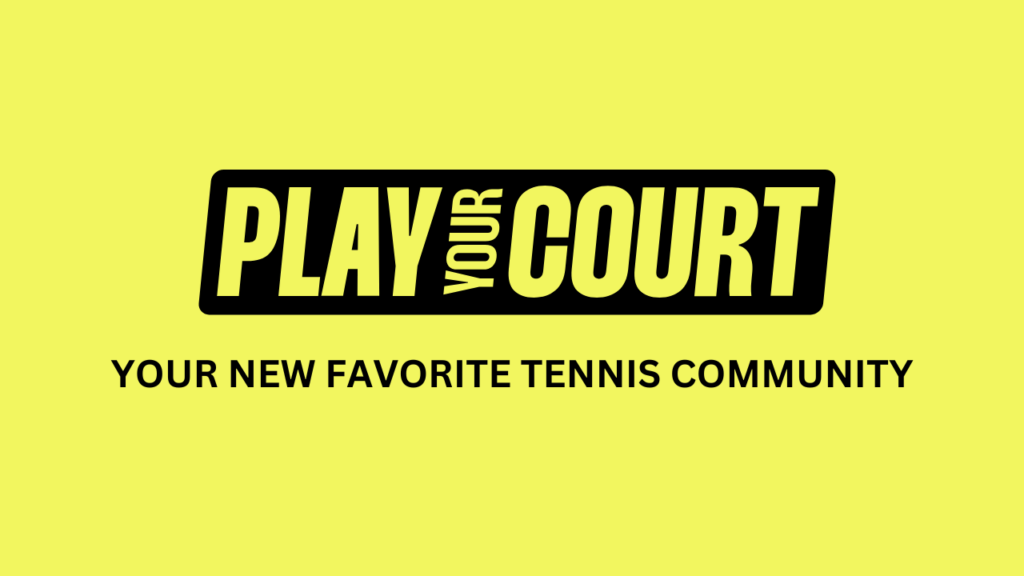
If there’s one thing I hope you’ve taken from this guide, is about building a complete, tennis-ready body.
Whether you’re working on speed, strength, balance, or endurance, off-court training is the missing link that turns practice into real, measurable results.
When you train your body the right way, everything changes. You move faster, hit harder, and last longer, unlocking levels of play you didn’t think were possible.
Our membership is your all-in-one roadmap to real game breakthroughs.
From guided challenges to video tips, personalized coaching, and match tracking tools, we give you everything you need to train smarter, stay motivated, and finally see the results you’ve been working for.
Ready to put this into action? Try PlayYourCourt’s membership to supercharge your tennis fitness and take your game to the next level, faster than you thought possible.
